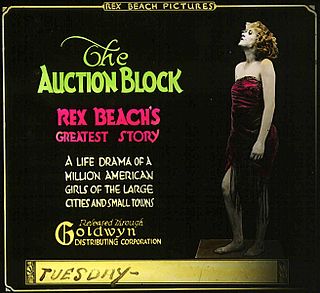
The Phantom Riders is a 1918 silent American Western film directed by John Ford and featuring Harry Carey. The film is considered to be lost.

The Mystery Ship is a 1917 American adventure film serial directed by Harry Harvey and Henry MacRae. The film is considered to be lost.

The Bull's Eye is a 1917 American film serial directed by James W. Horne. It is now considered to be a lost film.

The Fatal Ring is a 1917 American action film serial directed by George B. Seitz. Silentera.com reports that the UCLA Film and Television Archive may have a complete print. A deteriorating fragment roll containing a scene is discovered in France by Australian filmmaker Robert Hoskins in 2021 who then scanned it and uploaded it to his YouTube channel.

The Hidden Hand is a 1917 American film serial directed by James Vincent. This is a lost serial.

The Seven Pearls is a 1917 American silent action film serial directed by Louis J. Gasnier and Donald MacKenzie. Fragments are held by the Library of Congress.

Hands Up is a lost 1918 American adventure film serial directed by Louis J. Gasnier and James W. Horne. The serial was Ruth Roland's breakthrough role.

The House of Hate is a 1918 American film serial directed by George B. Seitz, produced when many early film studios in America's first motion picture industry were based in Fort Lee, New Jersey.

When a Woman Sins is a 1918 American silent drama film directed by J. Gordon Edwards and starring Theda Bara.

The Secret of the Storm Country was a 1917 American silent drama film directed by Charles Miller and starring Norma Talmadge. The film is described as not a direct sequel but a "continuation" of the 1914 film Tess of the Storm Country, starring Mary Pickford. The film is now considered lost.

Her Better Self is a 1917 American silent drama film starring Pauline Frederick and Thomas Meighan and directed by Robert G. Vignola. It was produced by Famous Players Film Company and distributed by Paramount Pictures. It is now considered lost.

The Serpent's Tooth is a 1917 American silent drama film starring Gail Kane from the stage and released through the Mutual Film company. It is a lost film.

Men was a 1918 American silent drama film directed by Perry N. Vekroff based upon a play by Harry Sophus Sheldon. It starred Anna Lehr, Charlotte Walker, and Robert Cain. It is considered to be a lost film.

The Auction Block is a 1917 American silent drama film directed by Laurence Trimble and starring Rubye De Remer. The film was produced by Rex Beach, upon whose novel, The Auction Block, the film is based. It is not known whether the film survives. The film was remade as a comedy in 1926 by Metro-Goldwyn-Mayer starring Charles Ray and Eleanor Boardman.
The Bride's Awakening is a 1918 American silent drama film released by Universal Pictures and produced by their Bluebird production unit. Robert Z. Leonard directed the film and his then-wife Mae Murray was the star. A print of the film is housed at the EYE Institute Nederlands.

The Hell Cat is a 1918 American silent Western film produced and distributed by Goldwyn Pictures. Reginald Barker directed and Geraldine Farrar starred. It is not known whether the film currently survives.

Exile is a 1917 American silent drama film directed by Maurice Tourneur and written by Charles E. Whittaker based upon the 1916 Dolf Wyllarde novel. The film stars Olga Petrova, Wyndham Standing, Mahlon Hamilton, Warren Cook, Charles Martin, and Violet Reed. The film was released in September 1917, by Paramount Pictures. It is not known whether the film currently survives, which suggests that it is a lost film.

Who Is Number One? is a 1917 American silent mystery film serial directed by William Bertram and written by Anna Katharine Green. The film stars Kathleen Clifford, Cullen Landis, Gordon Sackville, Neil Hardin, Bruce Smith, and Ethel Ritchie. The film serial was released on October 29, 1917, by Paramount Pictures. It is presumed to be a lost film.

The Hungry Heart is a 1917 American silent drama film directed by Robert G. Vignola and written by Charles Maigne based upon the novel of the same name by David Graham Phillips. The film stars Pauline Frederick, Howard Hall, Robert Cain, Helen Lindroth, and Eldean Steuart. The film was released on November 5, 1917, by Paramount Pictures. It is not known whether the film currently survives, and it may be a lost film.

The Fighting Trail is a lost 1917 American silent Western serial film directed by and starring William Duncan. It was produced and distributed by the Vitagraph Company of America. It was released in 15 chapters.



















